As far as I
could tell from the records that came with the '88 we got for my wife, the
brakes had never been serviced. At 22K miles, the brakes were squeaking and the
pads looked pretty thin. If these were the factory pads, they were putting out
a ![]()
I had never done brakes on an S4 before, so I thought I'd take a few pics of the process I went through in case it helps other Noobs like me. WARNING: there are a lot of pictures!
To start with, I did some pre-planning by inspecting the brakes for worn parts
to make sure new parts were ordered and on hand before starting the job. I
could tell by inspection that the front pads were worn. I took off the calipers
(described later) and measured the rotors thickness, inspected the brake hose
for cracks, worn spots or hardening, inspected the caliper piston boots for leaks
or wear.
It turns out that I only really needed front rotors and pads but decided to
replace all four rotors and pads. So I ordered and received the parts before
beginning.
Here's a pic of the tools and materials I used. It
includes:
1/2" drive pivot head ratchet, 19mm tall socket, 19mm short (regular
height) socket (6 point)
3/8" drive pivot head ratchet, 19mm tall socket, 19mm short socket (6
point), 10mm allen socket, 3" extension, 10mm
socket
1/2" and 3/8" drive torque wrenches
10mm combination wrench
Phillips head and slotted head screwdrivers
Standard pliers and channel lock pliers
6", 4", 3" C-Clamps
Brake Caliper Grease
Optimoly HT (Copper Anti-Seize)
Disk Brake Quiet
Brake Cleaner
Mother's Aluminum & Mag Polish
Caliper Paint (DupliColor - Silver)
High Temp. Engine Enamel (Duplicolor - clear coat)
Painter Blue Masking Tape


First, using the 19mm socket and 1/2" drive, loosen the lugnuts on all four wheels before lifting the car. Then,
safely lift the car off all 4 wheels and use Jack stands to support the car
(unless you're fortunate enough to have a lift! ![]()
I used Porken's lift bars. Which, by the way, I
ordered on a Saturday and he had manufactured and shipped and on my doorstep by
the following Thursday, just in time to start the brake job on Friday Morning!
THANKS Porken!![]()
![]()
![]()


I noticed that one of the wheel studs on each of the wheels had RED paint on
the end. After doing some research, I found that this lug is marked for
locating the factory locking lug nut. The red stud is supposed to be opposite
the valve stem when mounting the tire. Since the replaced the factory locking
lugs with the lighter 928Intl locking lugs, this probably isn't so important.
But nevertheless, I maintain the red lug across from the valve stem and put the
locking lug on that stud.

After taking off the wheel, you can inspect for obvious problems like leaks and
worn hoses. Lots of brake dust on the wheel well here...

Before taking off the caliper, you should open the cap on the brake fluid
reservoir and remove some fluid.

I used a suction bulb to remove a few oz. According to the service records,
this brake fluid was flushed and replaced with fresh in March, 2004 so I didn't
plan to flush and replace fluid yet. EDIT: I didn't realize the fluid needed to
be flushed and replaced at the time of this repair. The WSM recommends renewing
the brake fluid every 2 years. So I'll be flushing the brake fluid soon - might
even post a few pics!

Next, start removing the calipers. Use regular pliers and/or channel lock
pliers to squeeze the center of the retaining spring while pushing down on the
latched end (the end opposite the pivot end). According to the manual, it's
good to be careful (hence push down slightly at the latched end) so you don't
bend or damage the catch that holds the retaining spring in place. I used
channel lock pliers on the front springs and regular pliers on the rears. Also
note that the front retaining springs pivot at the bottom while the rear
retaining springs pivot at the top.

After releasing the retaining spring from the catch, you can pivot it down
somewhat and gain better access to the brake pad wear sensor. You remove this
by pulling it straight out and can use the flat blade screwdriver to give you
some leverage if it's tight. Be carful with how much
force you apply, the black plastic end can be brittle and break under too much
stress. I just take my time and slowly work it out.

With the brake pad wear sensor removed from the caliper, you can pivot the
retaining spring all the way down (front) or all the way up (rear) and squeeze
the spring together at the pivot point to remove the spring from the caliper. I
found it a litter easier to remove from one hole at a time.

Next, you can remove the pads from the calipers. I used 4" C-Clamps
mounted on the top of the pad and the outside of the caliper. You can use a
small cloth to place between the clamp and the caliper so you don't chip the
paint. You will also notice a small flat divot at the center of the caliper on
the front and this made a good spot to place the clamp. I turned the clamps
down just enough to clear about a millimeter of space between the pad and the
disk.

I also loosened the caliper bolts which gave added room to easily remove the
pads. You will need a 10mm allen
socket to loosen the caliper bolts.

At this point, you can remove the clamps and the pads should pull straight out
without fuss. You can see from this picture, the divot where you can place the
C-Clamp on the front of the caliper.
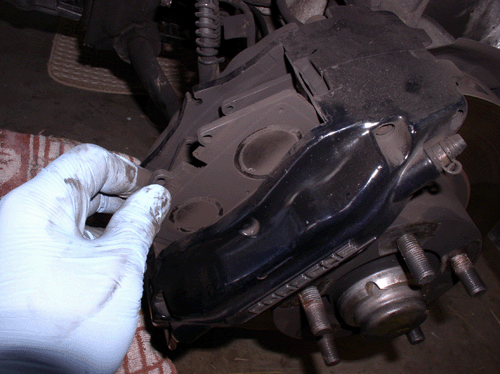
While removing the pads, you can look for anything unusual. It's a good idea to
keep track of which wheel and which side (inside/outside pad) the pads were from
in case you notice significantly different wear patterns on the pads. These
looked fine although there was a reddish tint under the camera.

Now you can remove the caliper bolts completely and pull the caliper off the
mounting. I set the caliper on a small box with a towel on it to work on
inspecting and pushing in the pistons. Once off, check the piston boots for
leakage or rips or other damage. These looked fine.

Since front pads were very worn, the pistons were
extended quite a bit. In order for the new, thicker pads to fit, I needed to
push the pistons back in. I used the 6" C-Clamp for this (remember to use
a cloth pad between the clamp and the caliper facing). You can use the old pad
(if you aren't going to reuse them) to clamp against the pistons. I had
marginal success with this approach as I found with the clamp in the center,
the pistons would not go in equally....

So, I turned the old brake pad on end and pressed the pistons in one at a time.
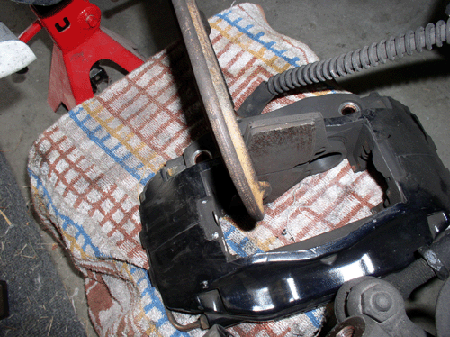
While pressing in the pistons, you need to carefully watch the brake fluid reservior level as you pump fluid back into the reservoir.
Since my pistons were extended, I had to remove more fluid.
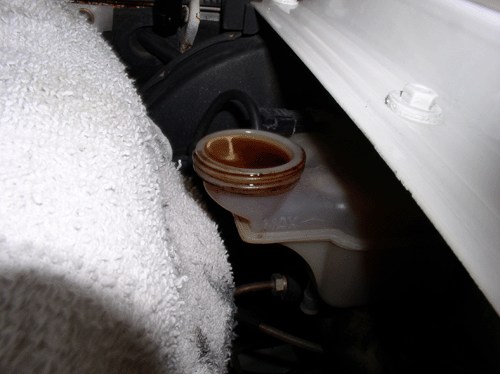
I pressed the pistons in until they were level with the inside caliper surface.
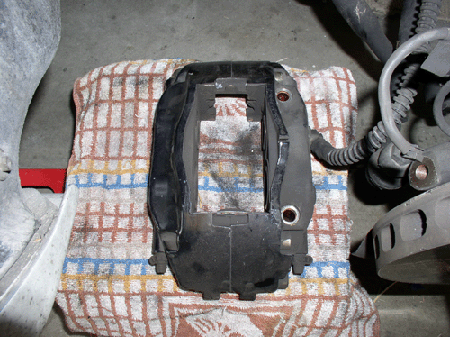
Next you can remove the rotor. It's held in place by two philips head screws. They should not be too difficult
to remove since they are only supposed to be torqued
to 7 ftlbs. Use a large philips
screwdriver so you can get a good grip. You'll have to hold the rotor with one
hand while breaking the screws free....

...and remove the rotor from the wheel. Once the rotor is off, you can access
the rotor shield. However, I could not find an easy way to remove it for
cleaning without removing the hub. Since the wheel bearings seemed to be in
perfect order with no play, I decided to simply clean the shield in place
(described later).
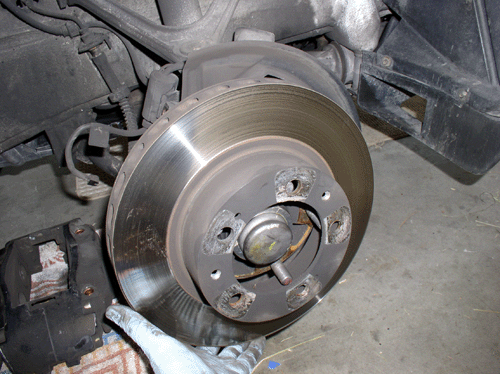
For the rear brakes, remove the retaining spring, brake pad wear sensor and
brake pads in the same manner you did the front brakes (except the retaining
spring pivots UP instead of down).

To remove the rear calipers, you will need the 19mm socket. I found the pivot
head 1/2" ratchet to work well in breaking these bolts free. The ratchet I
used has a long handle and provided extra leverage.
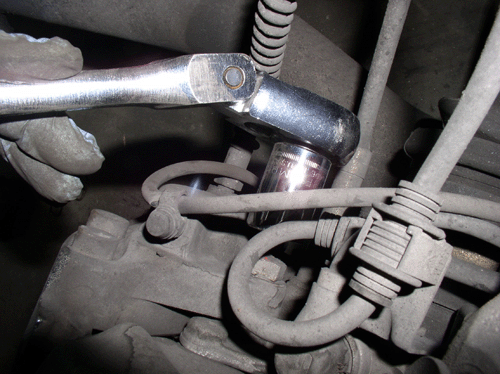
Next remove the rotor as you did the front.

Once the rotor is removed from the rear wheel, you can access the retaining
bolts for the rotor shield. I planned to take the shield off and clean it. It
has 4 10mm bolts holding it in place. The one in the center, shown in the
picture, has a 10mm self-locking nut on the other side you will need to counterhold/remove first before you can unscrew the bolt
from the front side.
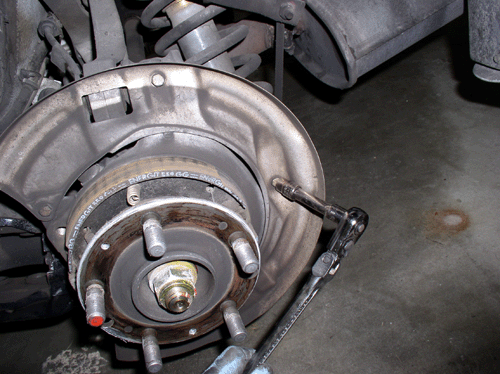
After the bolts are off, remove the shield.
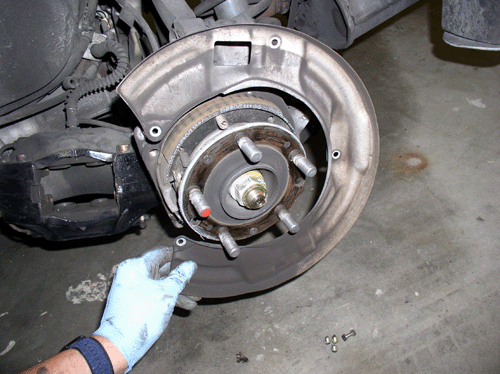
Since the brake pad retaining springs are different sizes for front and rear, I
kept all the hardware grouped by wheel.
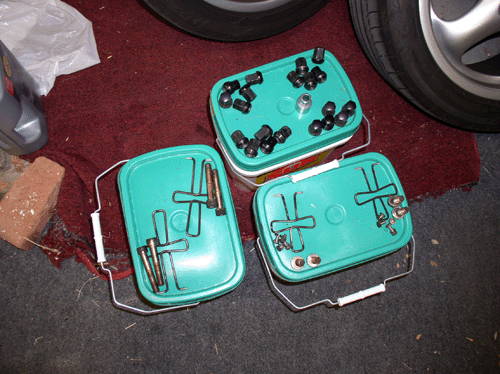
Next, you can clean the wheel wells and calipers. Even though I had inspected
the hoses before starting the job, after they were cleaned, I decided to
inspect them again. I check for obvious cracking.
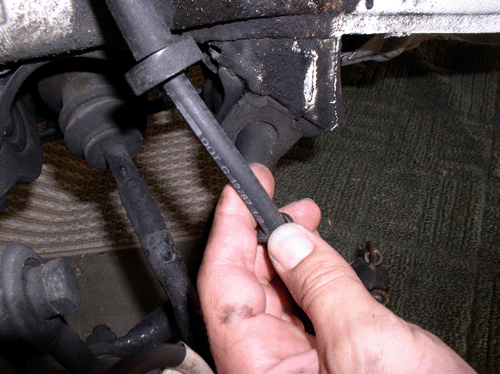
Also try bending the hose and see if it is stiff or cracks show up. These
appeared to be fine.

Also inspect the brake pad wear sensor. If the plastic head is worn down to the
wire and wire is exposed, you probably should have been experiencing brake sensor
light on the instrument panel and the sensor should be replaced. If the wire is
still intact, you can reuse. These appeared to be fine with little to no wear
on the plastic head.
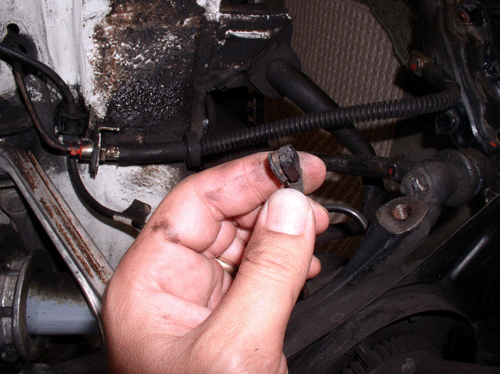
Measuring the rotor thickness was done before starting the job but I did it
again here with pictures. The front rotors here ended up being 30.61mm and
30.53mm thick for the Passenger and Driver side front, respectively. The
minimum thickness allowed according to the WSM is 30mm. A new rotor is supposed
to be 32mm thick. So it was time to change the front. The rear rotors were
23.44mm and 23.37mm thick for passenger and driver sides, respectively. Minimum
thickness is 22mm and new rear rotors are supposed to be 24mm thick. So we
could have gone longer with the rear rotors before replacing.
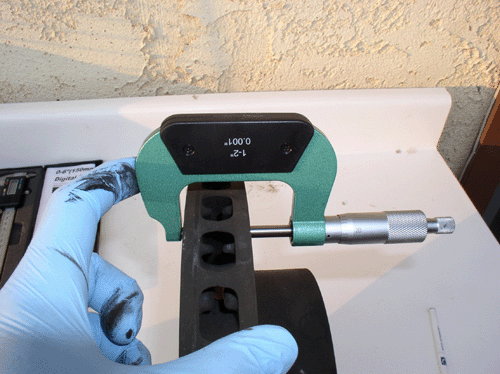
For the pads, I found it easier to measure the thickness of the pad backing
plate (5.95mm thick) and subtract that from the total pad+backing
thickness.
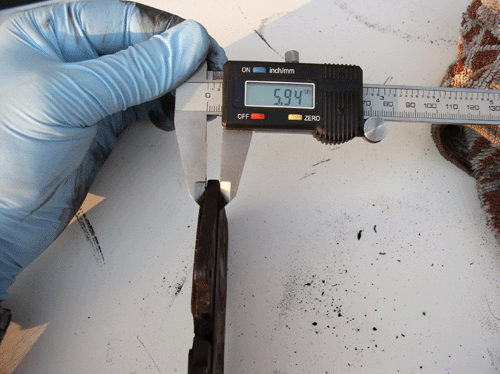
The total thickness for the font driver's was 9.13mm - 5.95mm for backing =
3.18mm thick. The passenger side was 9.32mm - 5.95mm for backing = 3.37mm
thick. Minimum thickness is 2mm. So there was a little more than 1mm left on
the fronts before minimums. The rears had plenty of pad
left but I replaced them anyway since new rotors were going on all around.
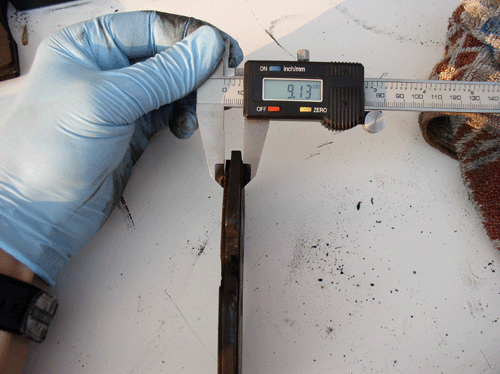
Next, you can prepare the rotors for paint. I paint the rotor hats only for all
four rotors. First, clean the rotor hat surface of any contaminants. I used
brake cleaner and a clean rag.

I use blue painters tape to mask the rotor surface. It leaves minimal residue
behind. I cut small strips (about 1/2" wide) of the tape and place them
around the groove that lies between the rotor surface and the base of the rotor
hat. The smaller the strips, the closer you can get to a perfect circle.
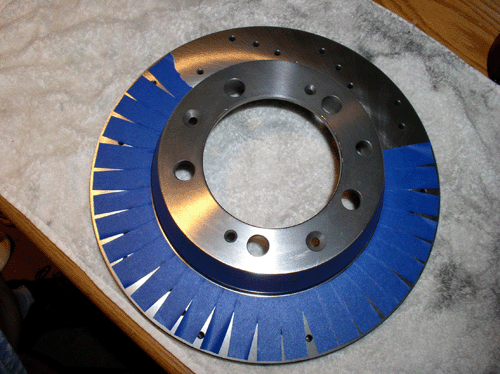
Then place longer stips of tape across the small
strips to cover the gaps.
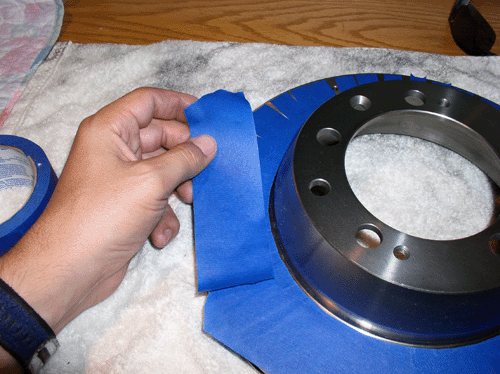
Wrap a strip of tape around the edge of the rotor and tape the inside of the
rotor hat to prevent paint spray from getting inside the hat.
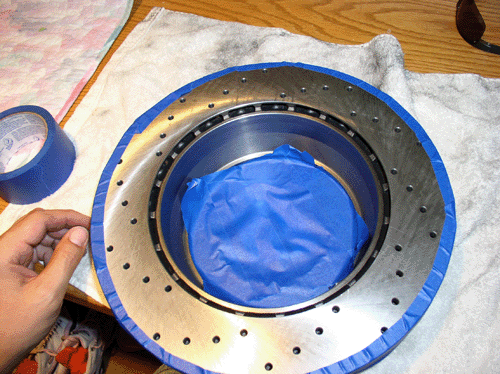
When It's all taped up, you are ready for paint.
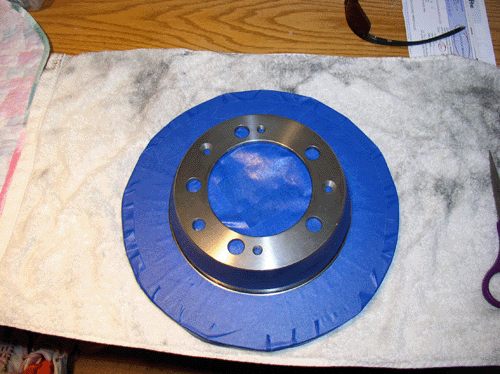
Tape and prepare all four for paint at the same time.
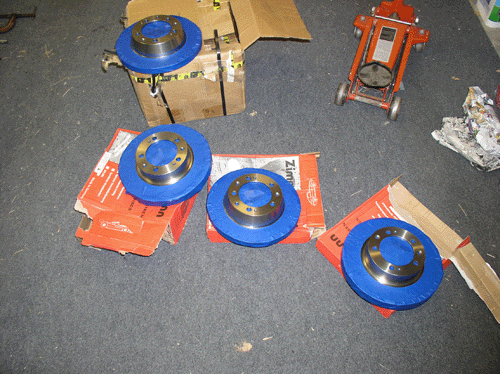
I used Duplicolor Caliper silver caliper paint. Three coats of paint followed by three coats of High Temp. Engine Enamel Clear Coat.
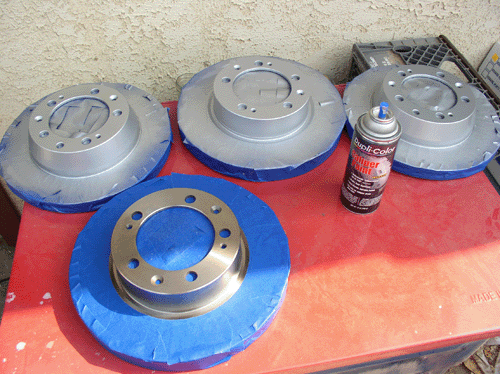
I let the paint dry/harden for at least 24 hours before mounting the wheels
against them.
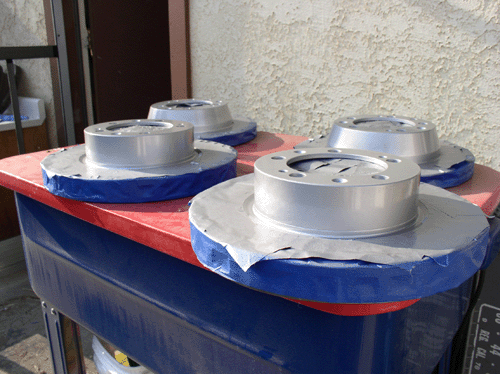
Next, I
cleaned the front rotor shields.
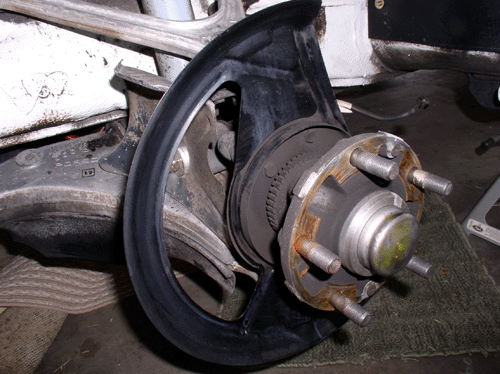
After washing off with cleaner, I thought I'd try applying regular Turtle Wax
to see if it would help repel brake dust and ease cleaning next time I cleaned
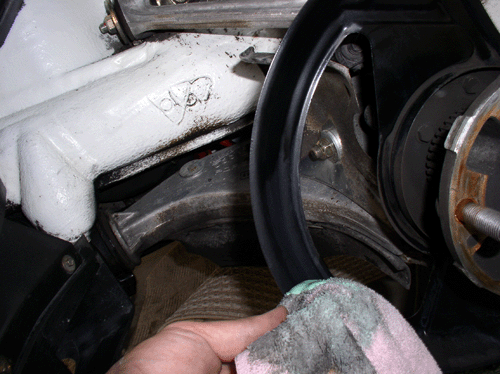
The wax did clean them up better than regular washing.

Next were the rear rotor shields. First I cleaned them with citrus cleaner.
Here's the before and after. They cleaned up fairly well so I decided not to
give them an acid bath like I had to do on the '84 rotor shields.
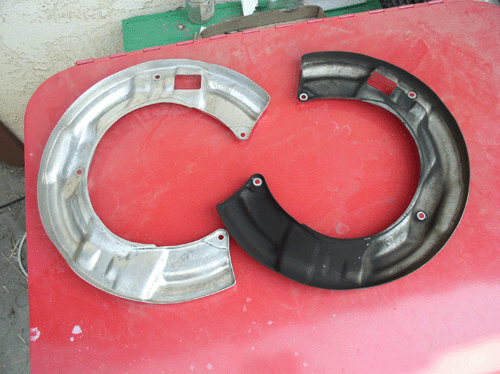
To get a little more shine, I decided to try Mother's Aluminum & Mag Polish on them and it worked great! I got the idea from
Stan (Mrmerlin) at SATL last month when he showed me
how nice the top of his radiator looked after polishing it. I was so impressed
with the mirror like shine, I had to try it myself.
THANKS, Stan! ![]()
![]()
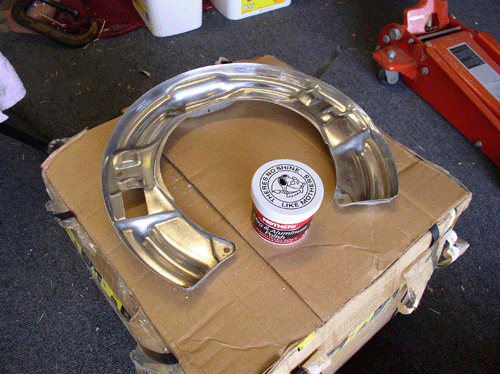
Here's both shields after polishing and ready for
installation.
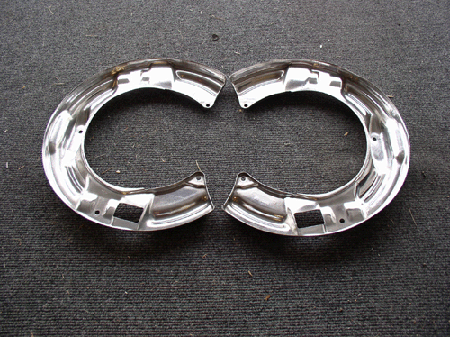
Another experiment I thought I'd try is to apply wax to to
the brake pad retaining spring. Again, just to see if it repelled brake dust
and made future cleaning easier. I'll let y'all know if it works.
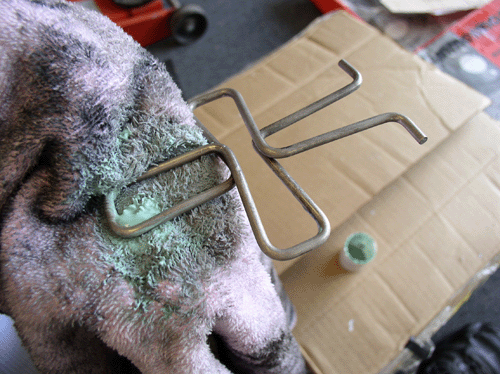
Next, you can prepare the rotors for install. Remove the masking tape....

....and clean
the rotor surface with brake cleaner to remove any tape residue that may be
left. DO NOT SPRAY BRAKE CLEANER ON THE PAINTED
SURFACES. The Clear Coat does not like Brake Cleaner! Instead, spray the
cleaner on a clean rag and use the rag to wipe the rotor surface.
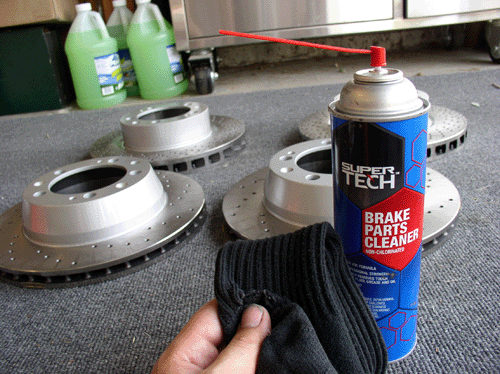
Now you can install the rear rotor shields....
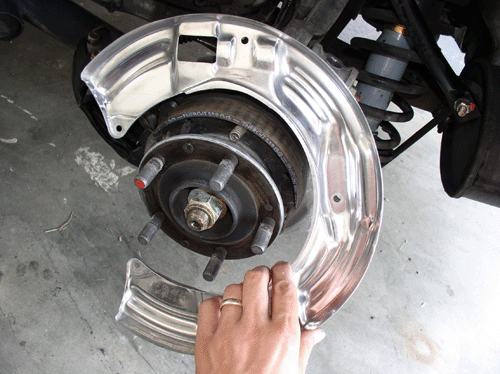
....install the Four bolts and remember....
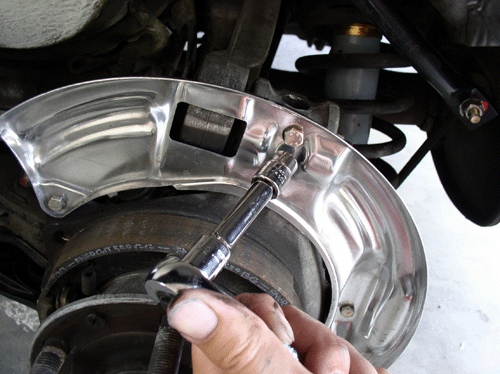
....on the middle one to install the 10mm nut at the back that holds the
bracket in place.
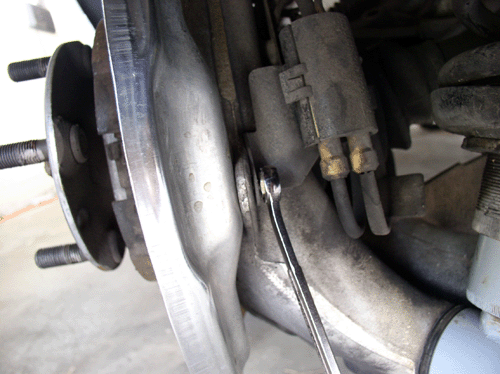
Once the rotor shield is in place.......
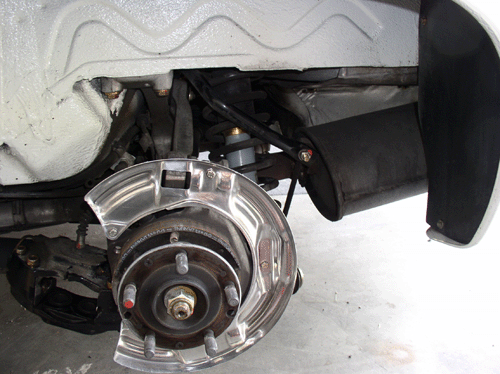
....mount the rear rotor. It does not make any
difference which wheel the rotors are assigned - it does matter on the front.
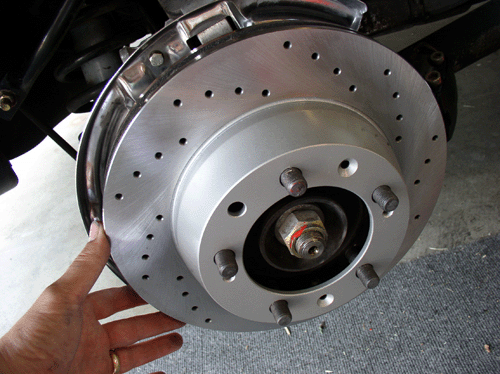
Install the screws and tighten to 7 ftlbs.
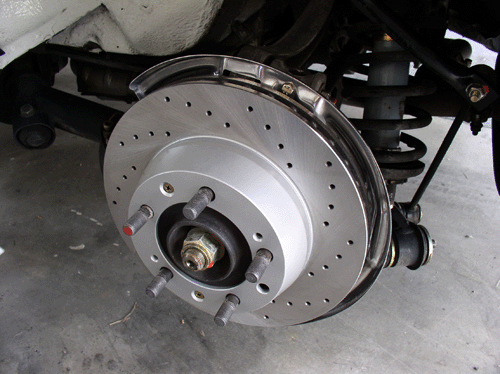
Next, mount
the front rotors. These are marked Left and Right.
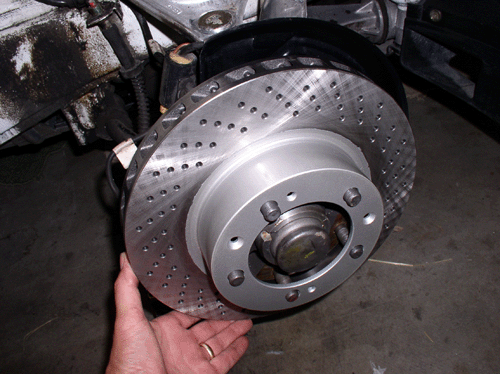
And secure with the phillips
screw at 7 ftlbs.
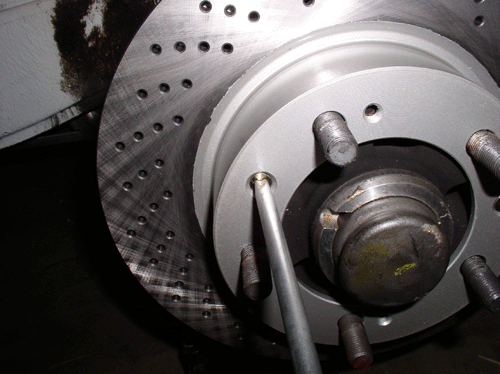
Some of the lug nut studs barely had any red paint visible so if you want to
freshen the paint on the studs, now's the time. First clean the surface with
brake cleaner....
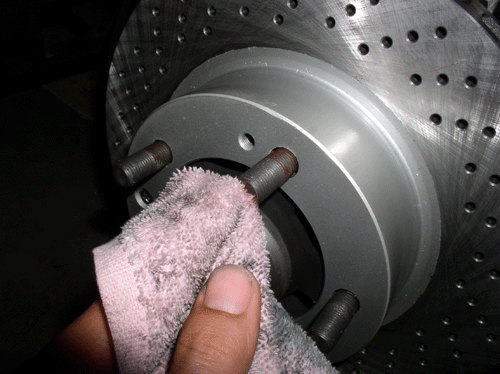
...and apply body paint. I just picked any red color.
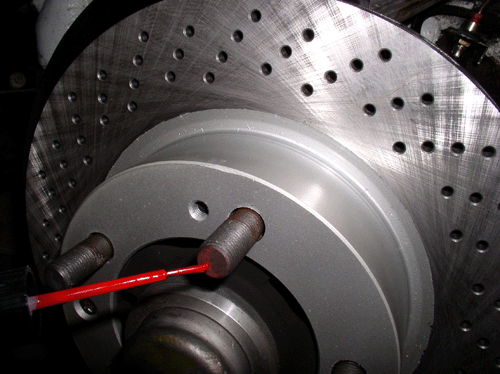
At this point, you can install the calipers and brake pads. First need to
prepare the pads....
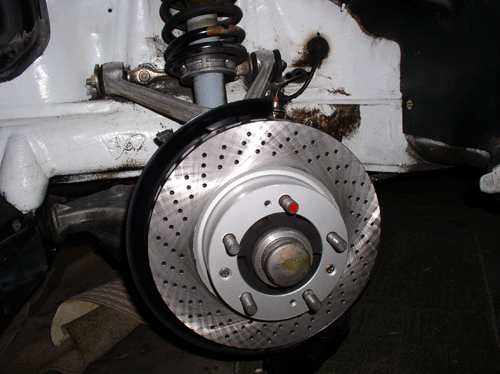
When I installed the new pads on the '84 earlier, I had trouble fitting the
brake pad wear sensor in the slot of the new pads. I figured it was because on
some of the pads, there were rough metal edges that were binding the sensor.
So, this time I decided to file the slots where the sensor resides to ensure a
smooth fit and no broken sensors.
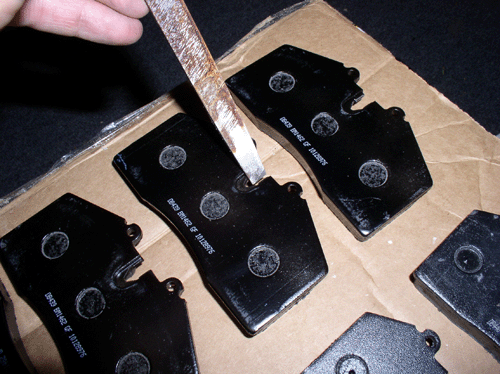
I apply Disk Brake Quiet to the back of the pads.
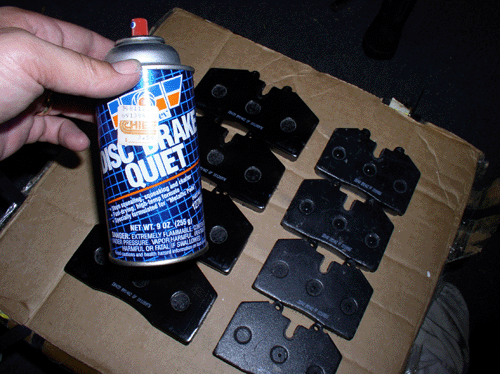
One moderate coat is sufficient to keep the brakes quiet. Spray from the top
down and not at an angle from the sides - you do not want to get this stuff on
the pads.
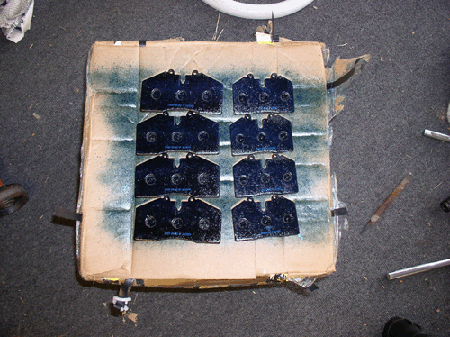
I noticed that the Caliper bolts had copper anti-seize on them when I removed
them so I applied a fresh dose before re-installing them.
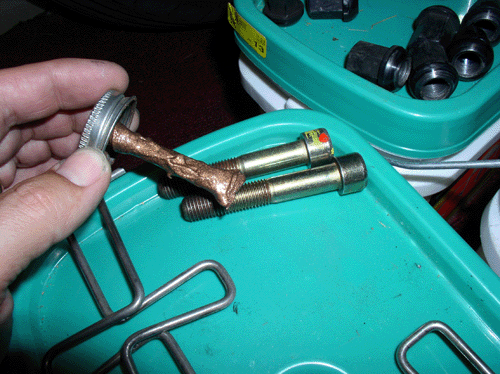
Next, position the caliper on the mounting....

....and install the allen
head bolts but do not tighten all the way yet. I like to keep the caliper a
little loose while fitting the pads.
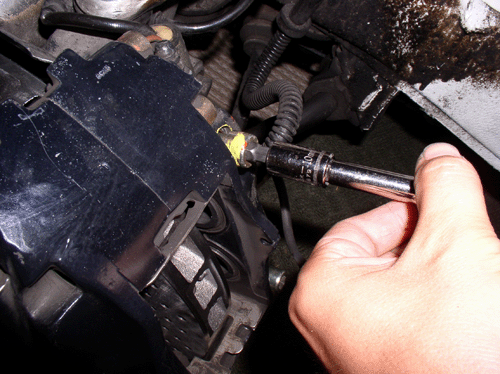
Then insert the brake pads....
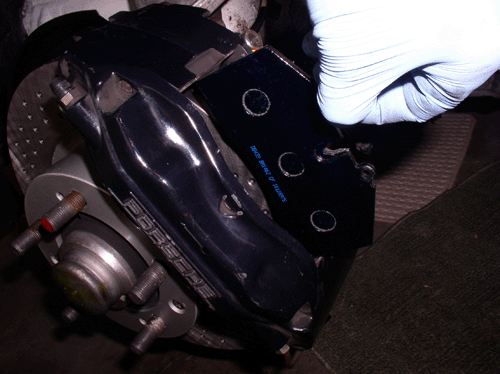
...and ensure they are fully seated.

Install both pads before tightening the caliper bolts.
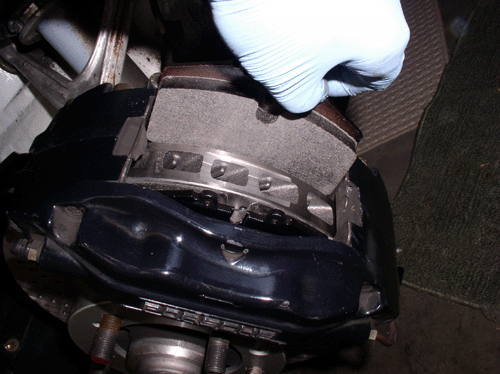
You can confirm they are fully seated by checking to make sure the top of the
brake pad material is just below the outer rim of the rotor.
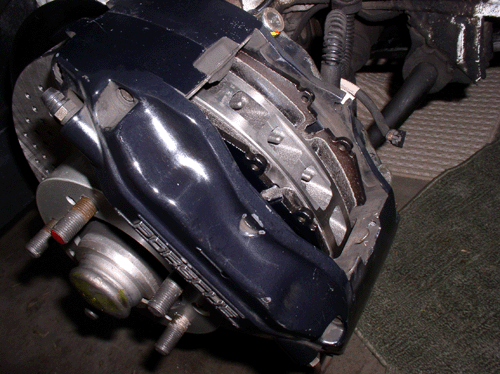
Next, you can
re-install the pad retaining spring. I thought I'd use brake caliper grease on
the contact points of the spring to reduce the chance of squeak.
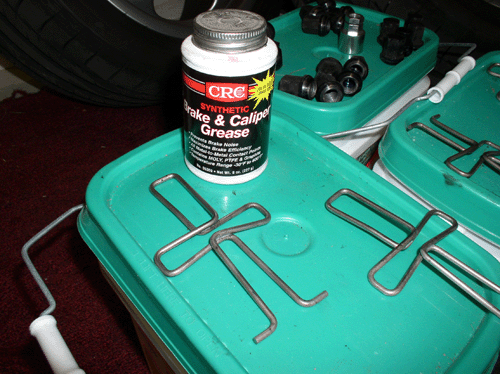
The contact points are pretty easy to see....just look for the worn spots on
the spring and apply a very small amount of grease.
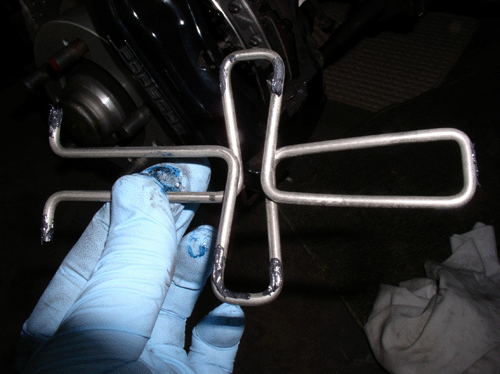
To install the spring, position the pivot end at the receiving holes on the
caliper and squeeze the ends together enough so you can instert
the spring into the holes.
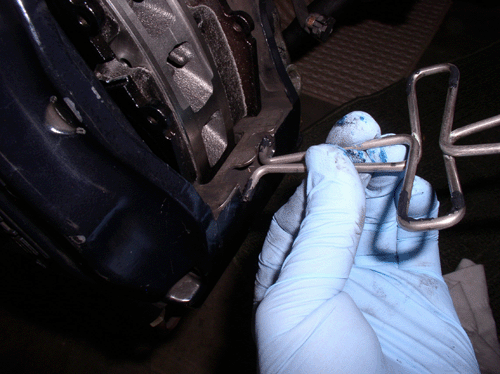
Using the pliers, squeeze the center of the spring together to give enough
clearance to slide the end of the spring in under the catch at the top of the
caliper.

Then set the brake pad wear sensor in position through the retainer spring...
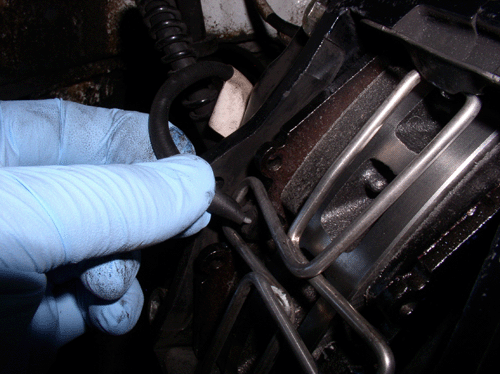
...and guide it down into the slot in the brake pad. You can use the flat blade
screwdriver to press it down into place - just be careful not to force it or it
could break. Take your time and ensure it is fully seated.

Next, push the brake pad wear sensor wire/housing down into the holding slot in
the caliper.
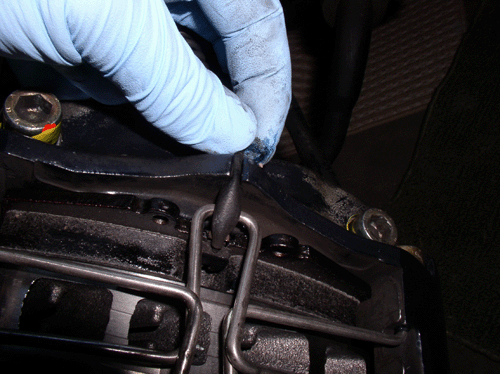
Then torque down both of the 10mm Allen Head caliper bolts to 62 ftlbs.

Now the assembly is ready to install the wheel.
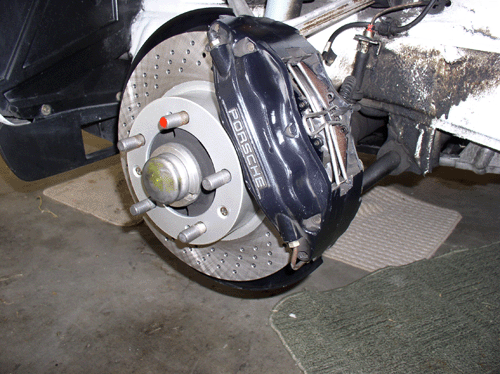
For the rears, assembly is the same as the front except the spring spring is installed upside down compared to the front
spring and the caliper bolts are a little trickier to get to with the torque
wrench. They are tightened to 62 ftlbs as well.
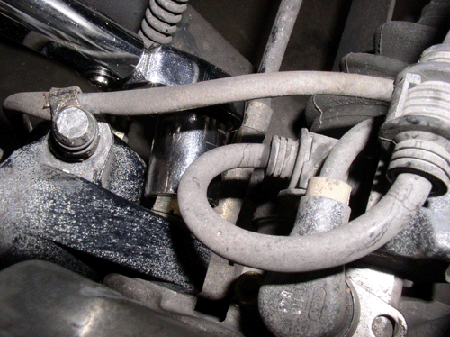
Now you are ready to install the wheels. I decided to wash and wax them before
reinstalling them. Here's the before and after.
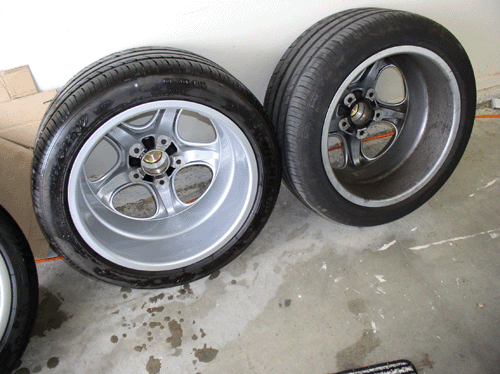
When placing the wheels, remember to orient the red stud.....
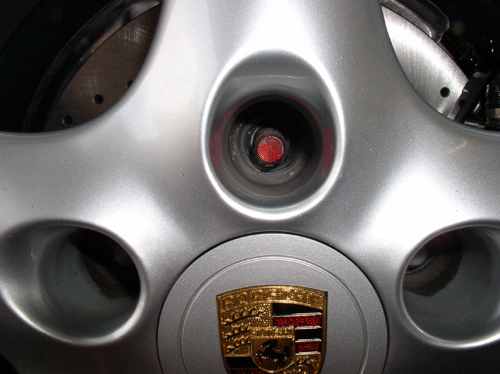
....so it's opposite the valve stem.
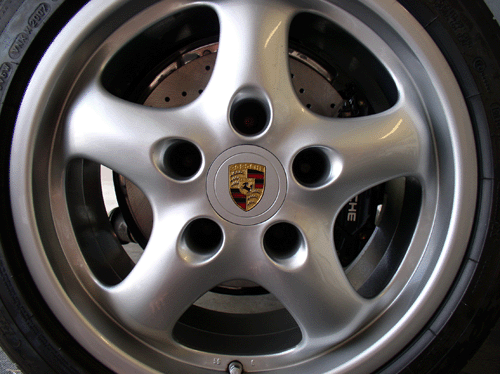
Snug down all the lug nuts. Now's a good time to apply tire
conditioner to the sidewalls of the tires if you wish. Before lowering
the car, I started the car and worked the brakes until the pads were seated
against the rotors and monitored the brake fluid level to make sure it did not
get low enough to suck air into the lines. As it turns out, I did not need to
add any fluid. You should not have to bleed air out of the lines since the
bleeder valves were not opened and the fluid level never reached low levels in
the reservoir. Replace the cap on the brake fluid reservoir. Still a good idea
to check for leaks before lowering the car.
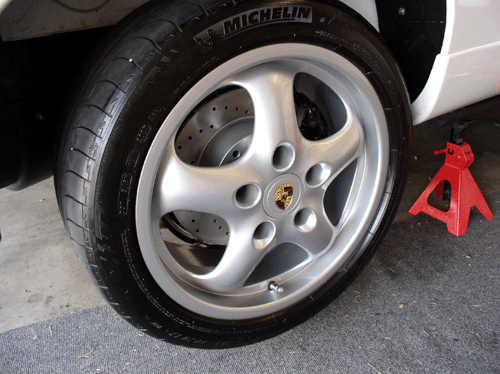
Now you can lower the car.
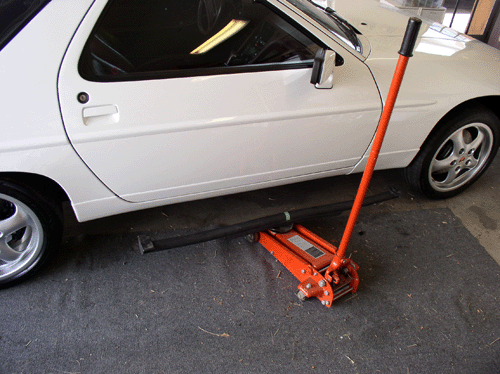
Finally,
Torque down the lug nuts to 96 ftlbs with the 19mm
socket. And you're done!
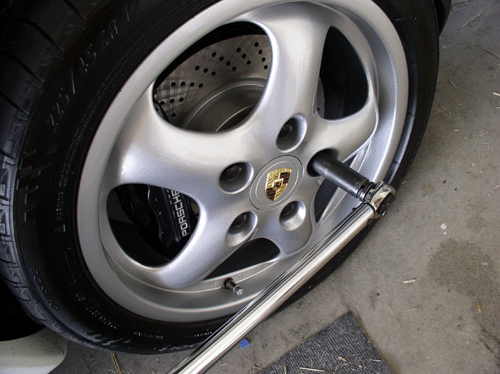
Recommended break-in depends on what kind of driving one does (city or hiway). We're using about 100 mile breaking in period since
it's driven mostly in the city. I used about 300 miles on the '84 since it's
mostly highway driving.